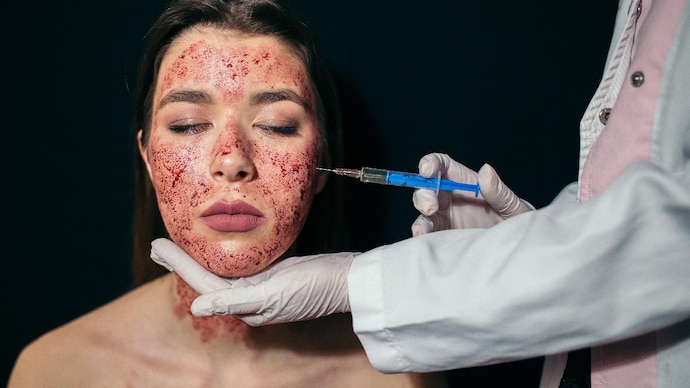Does a Vampire Facial Hurt? Pain and Sensation FAQ
When considering skin rejuvenation options, many people ask, does a vampire facial hurt? This popular treatment, which combines microneedling with platelet-rich plasma (PRP) therapy, promises radiant, youthful skin. However, concerns about pain and sensation during the procedure often arise. Understanding the typical feelings during and after the Vampire Facial (وجه مصاص الدماء) treatment can help you prepare mentally and physically, ensuring a more comfortable experience.
The Importance of Knowing What to Expect:
Knowing what sensations to expect during a vampire facial is essential for setting realistic expectations and easing any anxiety. Since the treatment involves tiny needle pricks and the application of your own blood-derived plasma, it’s natural to wonder about discomfort levels. Being informed about pain management options and typical sensations also helps in deciding if this treatment aligns with your comfort threshold and lifestyle.
What Happens During a Vampire Facial?
The vampire facial begins with drawing a small amount of your blood, which is processed to extract platelet-rich plasma (PRP). Then, microneedling is performed, creating microscopic punctures in the skin to stimulate collagen production. The PRP is applied to the skin, promoting healing and rejuvenation.
The procedure’s unique combination is designed to optimize skin repair but naturally involves physical sensations, primarily from the microneedling process.
Understanding Pain and Sensation During the Procedure:
Many describe the microneedling portion of the vampire facial as a tingling or prickling sensation. Thanks to the application of a topical numbing cream before treatment, most people report minimal pain. However, the intensity of sensation can vary depending on individual pain tolerance and the sensitivity of the treated area.
- Some feel only mild discomfort or a slight scratching feeling.
- Others might experience a warmer or stinging sensation as the PRP is applied.
- The numbing cream usually makes the microneedling phase manageable for most.
It’s important to communicate with your provider during the treatment so adjustments can be made if discomfort increases.
Risks Related to Pain and Sensation:
While pain during a vampire facial is generally mild, some risks associated with sensation include:
- Temporary redness and swelling that may cause sensitivity or tenderness afterward.
- Mild bruising in sensitive skin types due to microneedling.
- Rare allergic reactions to topical numbing agents, leading to itching or irritation.
- Overly aggressive treatment can increase discomfort and prolong healing time.
Following pre- and post-treatment care instructions minimizes these risks and helps keep discomfort to a minimum.
Benefits Beyond the Sensation:
Despite mild pain or tingling during treatment, the benefits of Vampire Facial treatment(العلاج بامتصاص الدماء لشد الوجه) are notable:
- Natural stimulation of collagen and elastin promotes long-term skin rejuvenation.
- Reduction in fine lines, wrinkles, and acne scars improves overall texture.
- Enhanced skin hydration and glow from the regenerative effects of PRP.
- Use of your own blood components reduces risk of allergic reactions or rejection.
These benefits make the brief sensation of discomfort worthwhile for many seeking refreshed skin.
Frequently Asked Questions About Pain and Sensation:
Is the vampire facial more painful than regular microneedling?
The addition of PRP does not increase pain significantly; numbing cream helps manage sensations similarly.
How long does the discomfort last after the procedure?
Mild redness and sensitivity usually fade within 24 to 48 hours, with some lingering tightness possible for a few days.
Can pain be completely avoided?
Topical numbing minimizes pain but a slight tingling or prickling feeling during microneedling is typical.
Is there any pain during the blood draw?
Blood drawing is quick and usually causes only minor discomfort, similar to a routine blood test.
What can I do to reduce discomfort after the facial?
Applying cold compresses and avoiding sun exposure helps soothe the skin and reduce irritation.
Conclusion:
So, does a vampire facial hurt? For most people, the answer is no more than mild discomfort thanks to numbing agents and professional technique. The sensations experienced—from gentle needle pricks to a warming feeling from PRP application—are generally tolerable and short-lived. Understanding these sensations, the risks involved, and effective pain management options helps you approach the treatment with confidence. Ultimately, the skin-enhancing benefits make the minor, manageable sensations a small price to pay for rejuvenated, radiant skin.
